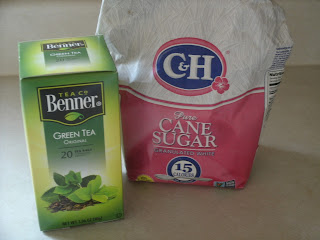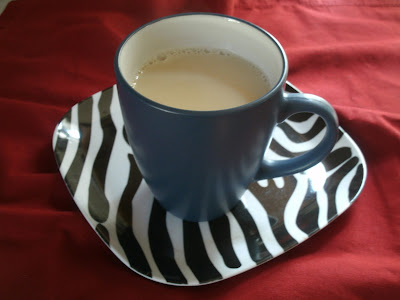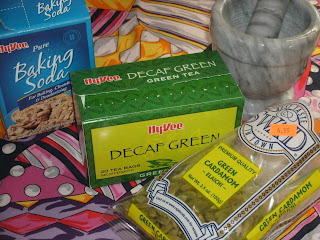Ginger cinnamon
Today we are visiting an old favorite. Ginger cinnamon tea. This was listed as being popular in Haiti, and Dominican Republic.
Haiti and Domincan Republic share the island of Hispaniola. Haiti is on the west side of the island, and includes several small islands as well. The people there are descendants of African slaves, and they won their independence from France in 1804. Fun fact: they are the second country in the Americas to gain their independence. Cuba is 50 miles away, and Jamaica is 120 miles away. Haiti is mountainous with rocky shores rimmed with cliffs. There are 4 mountain ranges that run along the middle of the island. Being on the leeward side of the island, there are some dry areas. They also have a tropical climate where temperature is moderated by elevation. This positioning also helps protect them somewhat from hurricanes although the southern peninsula is more vulnerable. Much of the native vegetation was cleared for agricultural land from the 17th to 19th centuries. Small areas of forest still remain. They include a wide range of plants from pine trees, to cacti, to acacia trees. As you would expect, the loss of the natural plants also meant a loss of the native wildlife, but caimans and flamingos still remain.
Haiti is also the poorest country in the western hemisphere by many measures. 4/5 of the population lives in deep poverty with 3/5 of the population being unemployed or underemployed. Agriculture is the biggest part of the economy, and they still have to import food. Most people work in what we would call the gig economy.
By contrast, the Dominican Republic covers the eastern 2/3 of the island. They also lay claim to several small islands around them as well. They are considered to be part of Latin America, and they are in a much different situation than their neighbors to the west given their position along trade routes through the Panama canal. Their side of the island contains the highest and lowest points in the West Indies chain of islands. Their mountains are described as being less rugged, and they have a moderate tropical climate thanks to the trade winds. They also get much more rain on the windward side of the mountains. They have more forest land than their neighbors, although the trees at lower elevations have been largely cut down for charcoal. The land is more fertile, and they have mangrove swamps, and sandy beaches. Wild animals are not abundant on their side of the island either, with livestock predominating animal life. Both countries have young populations with about 20% of the population being in the 30-44 age range (where I am currently). The population is a mix of European and African ancestry, and while Haiti has just over half of its population living in urban areas, Dominican Republic has been urbanizing with about 70% of its population in urban areas now.
Given their proximity, it makes sense that they drink similar but different kinds of tea. I found that plain ginger tea was listed for Dominican Republic, and ginger cinnamon for Haiti, but I decided to talk about them together here. This is also another post that lost its pictures (so much for trying to write posts ahead - I guess that's what you get for using a free platform...), so the formatting will yet again be a little wonky.
You may recognize this photo from another tea experiment. This plate is just missing a clove of garlic. Honest, I did split this part of the ingredients into separate pans. If you look closely, there is no garlic floating in this one!
I gave the ginger and cinnamon a nice simmer in some hot water, and enjoyed a cup of tea.
Sometimes simplicity is best, especially after suffering through tea with soy sauce in it. I still highly doubt that the soy sauce tea was how they really drank tea in the British Virgin Islands, but I didn't have anything else to go on, so I decided to be a sport. Thank you Haiti and Dominican Republic for a return to some more traditional teas.
Haiti and Domincan Republic share the island of Hispaniola. Haiti is on the west side of the island, and includes several small islands as well. The people there are descendants of African slaves, and they won their independence from France in 1804. Fun fact: they are the second country in the Americas to gain their independence. Cuba is 50 miles away, and Jamaica is 120 miles away. Haiti is mountainous with rocky shores rimmed with cliffs. There are 4 mountain ranges that run along the middle of the island. Being on the leeward side of the island, there are some dry areas. They also have a tropical climate where temperature is moderated by elevation. This positioning also helps protect them somewhat from hurricanes although the southern peninsula is more vulnerable. Much of the native vegetation was cleared for agricultural land from the 17th to 19th centuries. Small areas of forest still remain. They include a wide range of plants from pine trees, to cacti, to acacia trees. As you would expect, the loss of the natural plants also meant a loss of the native wildlife, but caimans and flamingos still remain.
Haiti is also the poorest country in the western hemisphere by many measures. 4/5 of the population lives in deep poverty with 3/5 of the population being unemployed or underemployed. Agriculture is the biggest part of the economy, and they still have to import food. Most people work in what we would call the gig economy.
By contrast, the Dominican Republic covers the eastern 2/3 of the island. They also lay claim to several small islands around them as well. They are considered to be part of Latin America, and they are in a much different situation than their neighbors to the west given their position along trade routes through the Panama canal. Their side of the island contains the highest and lowest points in the West Indies chain of islands. Their mountains are described as being less rugged, and they have a moderate tropical climate thanks to the trade winds. They also get much more rain on the windward side of the mountains. They have more forest land than their neighbors, although the trees at lower elevations have been largely cut down for charcoal. The land is more fertile, and they have mangrove swamps, and sandy beaches. Wild animals are not abundant on their side of the island either, with livestock predominating animal life. Both countries have young populations with about 20% of the population being in the 30-44 age range (where I am currently). The population is a mix of European and African ancestry, and while Haiti has just over half of its population living in urban areas, Dominican Republic has been urbanizing with about 70% of its population in urban areas now.
Given their proximity, it makes sense that they drink similar but different kinds of tea. I found that plain ginger tea was listed for Dominican Republic, and ginger cinnamon for Haiti, but I decided to talk about them together here. This is also another post that lost its pictures (so much for trying to write posts ahead - I guess that's what you get for using a free platform...), so the formatting will yet again be a little wonky.
You may recognize this photo from another tea experiment. This plate is just missing a clove of garlic. Honest, I did split this part of the ingredients into separate pans. If you look closely, there is no garlic floating in this one!
I gave the ginger and cinnamon a nice simmer in some hot water, and enjoyed a cup of tea.
Sometimes simplicity is best, especially after suffering through tea with soy sauce in it. I still highly doubt that the soy sauce tea was how they really drank tea in the British Virgin Islands, but I didn't have anything else to go on, so I decided to be a sport. Thank you Haiti and Dominican Republic for a return to some more traditional teas.






Sorry you keep having trouble with the pictures! I hope it will quit being wonky on you.
ReplyDeleteI hope it starts acting better, too. I swear I posted a response to this last week, but when I looked today, it was gone.
Delete